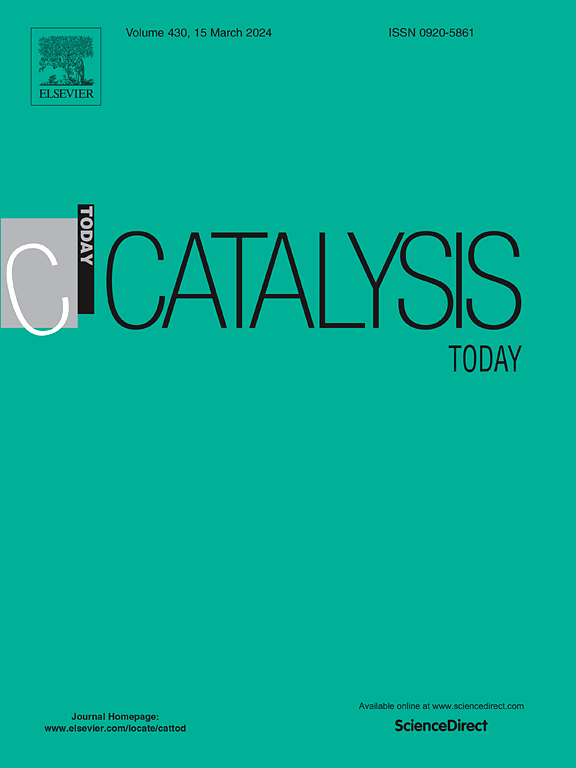一锅合成laccase@NH2-MIL-53(Al)间歇式连续流去除BPA的研究
IF 5.2
2区 化学
Q1 CHEMISTRY, APPLIED
引用次数: 0
摘要
尽管最近对双酚A (BPA)的使用进行了限制,但废水中仍然存在双酚A,对健康构成重大风险,需要有效的去除方法。已经提出了几种策略来解决这个问题,间歇反应器是最广泛使用的方法。然而,将去除系统扩大到连续流动条件对于实际废水处理的实际应用至关重要。本研究提出了一种利用负载型酶催化填料床反应器(PBR)去除双酚a的系统。在之前的研究中,我们证明了laccase@NH2-MIL-53(Al)催化剂在间歇式反应器中降解BPA非常有效,这要归功于它的高酶负荷和最小的酶浸出。该系统在5个反应循环中达到了超过80% %的去除效率,比自由酶系统运行得更快。在这项工作中,我们将该催化剂的应用扩展到PBR的连续流动条件下,与间歇式工艺相比,实现了更高的去除效率。在连续流动的情况下,即使在比典型环境中更高的污染物浓度下,生物催化剂也能长时间保持90% %以上的BPA去除率。该体系表现出显著的稳定性,没有扩散限制,表明酶对底物的可及性很高。此外,处理后样品的化学需氧量(COD)分析显示最小的增加,加强了系统的环境相容性和效率。这些发现突出了mof支持的漆酶在废水处理中的工业应用潜力,为BPA降解提供了可扩展和可持续的解决方案。本文章由计算机程序翻译,如有差异,请以英文原文为准。
Batch and continuous flow elimination of BPA with one-pot synthetized laccase@NH2-MIL-53(Al)
Despite recent restrictions on its use, bisphenol A (BPA) continues to be present in wastewater, posing significant health risks that require effective removal methods. Several strategies have been proposed to address this issue, with batch reactors being the most widely used approach. However, scaling up removal systems to continuous flow conditions is essential for practical application in real-world wastewater treatment. This study presents a BPA removal system utilizing a packed bed reactor (PBR) with supported enzymatic catalyst. In previous research, we demonstrated that the laccase@NH2-MIL-53(Al) catalyst was highly effective in degrading BPA in a batch reactor, thanks to its high enzyme loading and minimal enzyme leaching. The system achieved over 80 % removal efficiency along five reaction cycles, operating faster than free enzyme systems. In this work, we extend the application of this catalyst to continuous flow conditions in a PBR, achieving superior removal efficiencies compared to batch processes. Under continuous flow, the biocatalyst maintained over 90 % BPA removal for extended periods, even at higher contaminant concentrations than typical in environment. The system exhibited remarkable stability with no diffusional limitations, suggesting high substrate accessibility to the enzyme. Additionally, chemical oxygen demand (COD) analyses of treated samples showed minimal increases, reinforcing the environmental compatibility and efficiency of the system. These findings highlight the potential of MOF-supported laccase for industrial applications in wastewater treatment, offering a scalable and sustainable solution for BPA degradation.
求助全文
通过发布文献求助,成功后即可免费获取论文全文。
去求助
来源期刊

Catalysis Today
化学-工程:化工
CiteScore
11.50
自引率
3.80%
发文量
573
审稿时长
2.9 months
期刊介绍:
Catalysis Today focuses on the rapid publication of original invited papers devoted to currently important topics in catalysis and related subjects. The journal only publishes special issues (Proposing a Catalysis Today Special Issue), each of which is supervised by Guest Editors who recruit individual papers and oversee the peer review process. Catalysis Today offers researchers in the field of catalysis in-depth overviews of topical issues.
Both fundamental and applied aspects of catalysis are covered. Subjects such as catalysis of immobilized organometallic and biocatalytic systems are welcome. Subjects related to catalysis such as experimental techniques, adsorption, process technology, synthesis, in situ characterization, computational, theoretical modeling, imaging and others are included if there is a clear relationship to catalysis.
 求助内容:
求助内容: 应助结果提醒方式:
应助结果提醒方式:


